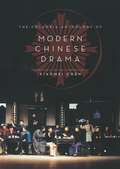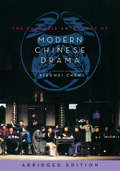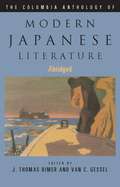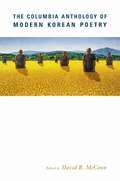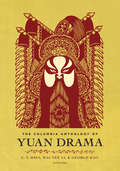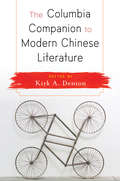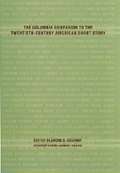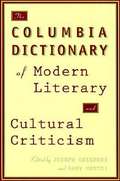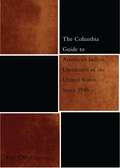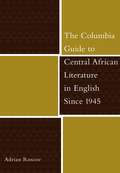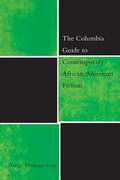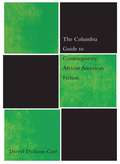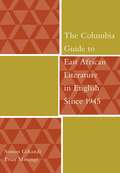- Table View
- List View
The Columbia Anthology of Modern Chinese Drama
by Xiaomei ChenThe first of its kind in English, this anthology presents translations of twenty-two popular plays published between 1919 and 2000, accompanied by an introduction to the historical, cultural, and aesthetic evolution of twentieth-century Chinese spoken drama. Primarily comprising works from the People's Republic of China, though including representative plays from Hong Kong and Taiwan, this collection showcases more than the revolutionary rethinking of Chinese theater and performance that began in the late Qing dynasty. It also reflects the formation of Chinese national and gender identities during a period of tremendous social and political change, as well as the genesis of contemporary attitudes toward the West.Early twentieth-century Chinese drama embodies the uncertainty and anxiety brought on by modernism, socialism, political conflict, and war. After 1949, the PRC theater paints a complex portrait of the rise of Communism in China, with the ideals of Chinese socialism juxtaposed against the sacrifices made for a new society. The Cultural Revolution promoted a "model theater" cultivated from the achievements of earlier, leftist spoken drama, despite the fact that this theater arose from the destruction of old culture. Post-Mao drama addresses the Chairman's legacy and the attempts of a wounded nation to reexamine its cultural roots. Taiwan's spoken drama uniquely synthesizes regional and foreign traditions, and Hong Kong's spoken drama sparkles as a hybrid of Chinese and Western influences. Immensely valuable for scholars of cross-disciplinary, comparative, and performance study, this anthology offers essential perspective on the theatricality and representation of political life.
The Columbia Anthology of Modern Chinese Drama (Weatherhead Books on Asia)
by Ed. Chen XiaomeiThe first of its kind in English, this anthology translates twenty-two popular Chinese plays published between 1919 and 2000, accompanied by a critical introduction to the historical, cultural, and aesthetic evolution of twentieth-century Chinese spoken drama. Primarily comprising works from the People's Republic of China, though including representative plays from Hong Kong and Taiwan, this collection not only showcases the revolutionary rethinking of Chinese theater and performance that began in the late Qing dynasty. It also highlights the formation of Chinese national and gender identities during a period of tremendous social and political change, along with the genesis of contemporary attitudes toward the West.Early twentieth-century Chinese drama embodies the uncertainty and anxiety brought on by modernism, socialism, political conflict, and war. After 1949, PRC theater painted a complex portrait of the rise of communism in China, with the ideals of Chinese socialism juxtaposed against the sacrifices made for a new society. The Cultural Revolution promoted a "model theater" cultivated from the achievements of earlier, leftist spoken drama, even though this theater arose from the destruction of old culture. Post-Mao drama addresses the socialist legacy and the attempts of a wounded nation to reexamine its cultural roots. Taiwan's spoken drama synthesizes regional and foreign traditions, and Hong Kong's spoken drama sparkles as a hybrid of Chinese and Western influences. Immensely valuable for cross-disciplinary, comparative, and performance study, this anthology provides essential perspective on China's theatricality and representation of political life.
The Columbia Anthology of Modern Chinese Drama: abridged edition (Weatherhead Books on Asia)
by Xiaomei ChenThis condensed anthology reproduces close to a dozen plays from Xiaomei Chen's well-received original collection, The Columbia Anthology of Modern Chinese Drama, along with her critical introduction to the historical, cultural, and aesthetic evolution of twentieth-century Chinese spoken drama. Comprising representative works from the Republican era to postsocialist China, the book encapsulates the revolutionary rethinking of Chinese theater and performance that began in the late Qing dynasty and vividly portrays the uncertainty and anxiety brought on by modernism, socialism, political conflict, and war. Chosen works from 1919 to 1990 also highlight the formation of national and gender identities during a period of tremendous social, cultural, and political change in China and the genesis of contemporary attitudes toward the West. PRC theater tracks the rise of communism, juxtaposing ideals of Chinese socialism against the sacrifices made for a new society. Post-Mao drama addresses the nation's socialist legacy, its attempt to reexamine its cultural roots, and postsocialist reflections on critical issues such as nation, class, gender, and collective memories. An essential, portable guide for easy reference and classroom use, this abridgment provides a concise yet well-rounded survey of China's theatricality and representation of political life. The original work not only established a canon of modern Chinese drama in the West but also made it available for the first time in English in a single volume.
The Columbia Anthology of Modern Japanese Literature (Abridged Edition)
by Van C. Gessel J. Thomas RimerJapanese literature.
The Columbia Anthology of Modern Japanese Literature, Volume 1: From Restoration to Occupation, 1868-1945
by Gessel Van C. J. Thomas RimerFirst volume of Japanese literature anthology.
The Columbia Anthology of Modern Japanese Literature: Abridged (Modern Asian Literature Series)
by J. Thomas RimerFeaturing choice selections from the core anthologies The Columbia Anthology of Modern Japanese Literature: From Restoration to Occupation, 1868–1945, and The Columbia Anthology of Modern Japanese Literature: From 1945 to the Present, this collection offers a concise yet remarkably rich introduction to the fiction, poetry, drama, and essays of Japan's modern encounter with the West. Spanning a period of exceptional invention and transition, this volume is not only a critical companion to courses on Japanese literary and intellectual development but also an essential reference for scholarship on Japanese history, culture, and interactions with the East and West.The first half covers the three major styles of literary expression that informed Japanese writing and performance in the late nineteenth and early twentieth centuries: classical Japanese fiction and drama, Chinese poetry, and Western literary representation and cultural critique. Their juxtaposition brilliantly captures the social, intellectual, and political challenges shaping Japan during this period, particularly the rise of nationalism, the complex interaction between traditional and modern forces, and the encroachment of Western ideas and writing. The second half conveys the changes that have transformed Japan since the end of the Pacific War, such as the heady transition from poverty to prosperity, the friction between conflicting ideologies and political beliefs, and the growing influence of popular culture on the country's artistic and intellectual traditions. Featuring sensitive translations of works by Nagai Kafu, Natsume Soseki, Oe Kenzaburo, Kawabata Yasunari, Mishima Yukio, and many others, this anthology relates an essential portrait of Japan's dynamic modernization.
The Columbia Anthology of Modern Japanese Literature: Volume 1: From Restoration to Occupation, 1868-1945 (Modern Asian Literature Series)
by J. Thomas Rimer Van GesselThis comprehensive anthology collects works of fiction, poetry, drama, and essay-writing from a pivotal time in Japanese history. In addition to their literary achievements, the texts reflect the political, social, and intellectual changes that occurred in Japanese society during this period, including exposure to Western ideas and literature, the rise of nationalism, and the complex interaction of traditional and modern forces. The volume offers outstanding, often new translations of classic texts by such celebrated writers as Nagai Kafu, Shimazaki Toson, Natsume Soseki, Kawabata Yasunari, and Yosano Akiko. The editors have also unearthed works from lesser-known women writers, many of which have never been available in English. Organized chronologically and by genre within each period, the volume reveals the major influences in the development of modern Japanese literature: the Japanese classics themselves, the example of Chinese poetry, and the encounter with Western literature and culture. Modern Japanese writers reread the classics of Japanese literature, infused them with contemporary language, and refashioned them with an increased emphasis on psychological elements. They also reinterpreted older aesthetic concepts in light of twentieth-century mentalities. While modern ideas captured the imagination of some Japanese writers, the example of classical Chinese poetry remained important for others. Meiji writers continued to compose poetry in classical Chinese and adhere to a Confucian system of thought. Another factor in shaping modern Japanese literature was the example of foreign works, which offered new literary inspiration and opportunities for Japanese readers and writers. Divided into four chapters, the anthology begins with the early modern texts of the 1870s, continues with works written during the years of social change preceding World War I and the innovative writing of the interwar period, and concludes with texts from World War II. Each chapter includes a helpful critical introduction, situating the works within their literary, political, and cultural contexts. Additionally, there are biographical introductions for each writer.
The Columbia Anthology of Modern Korean Poetry
by Ed. David McCannKorea's modern poetry is filled with many different voices and styles, subjects and views, moves and countermoves, yet it still remains relatively unknown outside of Korea itself. This is in part because the Korean language, a rich medium for poetry, has been ranked among the most difficult for English speakers to learn. The Columbia Anthology of Modern Korean Poetry is the only up-to-date representative gathering of Korean poetry from the twentieth century in English, far more generous in its selection and material than previous anthologies. It presents 228 poems by 34 modern Korean poets, including renowned poets such as So Chongju and Kim Chiha.
The Columbia Anthology of Yuan Drama
by George Kao C. T. Hsia Wai-Yee LiThis anthology features translations of ten seminal plays written during the Yuan dynasty (1279--1368), a period considered the golden age of Chinese theater. By turns lyrical and earthy, sentimental and ironic, Yuan drama spans a broad emotional, linguistic, and stylistic range. Combining sung arias with declaimed verses and doggerels, dialogues and mime, and jokes and acrobatic feats, Yuan drama formed a vital part of China's culture of performance and entertainment in the thirteenth and fourteenth centuries.To date, few Yuan-dynasty plays have been translated into English. Well-known translators and scholars have supervised the making of this collection and add a short description to each play. A general introduction situates all selections within their cultural and historical contexts.
The Columbia Anthology of Yuan Drama (Translations from the Asian Classics)
by Hsia C. T. Li George Kao Wai-YeeThis anthology features translations of ten seminal plays written during the Yuan dynasty (1279–1368), a period considered the golden age of Chinese theater. By turns lyrical and earthy, sentimental and ironic, Yuan drama spans a broad emotional, linguistic, and stylistic range. Combining sung arias with declaimed verses and doggerels, dialogues and mime, and jokes and acrobatic feats, Yuan drama formed a vital part of China's culture of performance and entertainment in the thirteenth and fourteenth centuries.To date, few Yuan-dynasty plays have been translated into English. Well-known translators and scholars have supervised the making of this collection and add a short description to each play. A general introduction situates all selections within their cultural and historical contexts.
The Columbia Companion to Modern Chinese Literature
by Kirk A. DentonMore than fifty short essays centered on specific writers and literary trends create an engaging and easily digestible history of Chinese literature from the Qing period (1895-1911) to today. The essays in this volume can be read sequentially for a chronological account or separately in conjunction with reading the literary works in Chinese or English-language translation. Each entry features author names and titles, as well as key terms and references, in English and in Chinese characters for readers who know or are learning Chinese, and each concludes with a bibliography of relevant primary and secondary sources.The volume opens with eight thematic essays addressing general issues in the study of Chinese literature: the ethics of writing a literary history, the formation of the canon, the relationship between language and form, the influence of literary institutions and communities, the effects of censorship, and the role of different media on the development of literature. Subsequent essays focus on authors, their works, and their schools, with entries on Wang Anyi, Eileen Chang, Shen Congwen, Yu Dafu, Mao Dun, Xiao Hong, Yang Jiang, Ba Jin, Yan Lianke, Ding Ling, Liang Qichao, Lao She, Wang Shuo, Zhu Tianwen, Zhu Tianxin, Xi Xi, Gao Xingjian, Lu Xun, Mo Yan, and Qian Zhongshu. Woven throughout are more general pieces on late Qing fiction, popular entertainment fiction, martial arts fiction, experimental theater, post-Mao avant-garde poetry in China, post-martial law fiction from Taiwan, contemporary genre fiction from China, and recent Internet literature, among other topics. Both a teaching tool and a go-to research companion, this volume is a one-of-a-kind resource for mastering modern literature in the Chinese-speaking world.
The Columbia Companion to Modern Chinese Literature
by Kirk A. DentonThe Columbia Companion to Modern Chinese Literature features more than fifty short essays on specific writers and literary trends from the Qing period (1895–1911) to the present. The volume opens with thematic essays on the politics and ethics of writing literary history, the formation of the canon, the relationship between language and form, the role of literary institutions and communities, the effects of censorship, the representation of the Chinese diaspora, the rise and meaning of Sinophone literature, and the role of different media in the development of literature. Subsequent essays focus on authors, their works, and the schools with which they were aligned, featuring key names, titles, and terms in English and in Chinese characters. Woven throughout are pieces on late Qing fiction, popular entertainment fiction, martial arts fiction, experimental theater, post-Mao avant-garde poetry, post–martial law fiction from Taiwan, contemporary genre fiction from China, and recent Internet literature. The volume includes essays on such authors as Liang Qichao, Lu Xun, Shen Congwen, Eileen Chang, Jin Yong, Mo Yan, Wang Anyi, Gao Xingjian, and Yan Lianke. Both a teaching tool and a go-to research companion, this volume is a one-of-a-kind resource for mastering modern literature in the Chinese-speaking world.
The Columbia Companion to Modern East Asian Literature
by Kirk A. Denton Bruce Fulton Lewis Cook Joshua S. MostowWith more than one hundred articles that show how a host of authors and literary movements have contributed to the general literary development of their respective countries, this companion is an essential starting point for the study of East Asian literatures.
The Columbia Companion to Modern East Asian Literature
by Bruce Fulton Lewis Cook Joshua S. Mostow the assitance of Kirk A. DentonThis extraordinary one-volume guide to the modern literatures of China, Japan, and Korea is the definitive reference work on the subject in the English language. With more than one hundred articles that show how a host of authors and literary movements have contributed to the general literary development of their respective countries, this companion is an essential starting point for the study of East Asian literatures. Comprehensive thematic essays introduce each geographical section with historical overviews and surveys of persistent themes in the literature examined, including nationalism, gender, family relations, and sexuality.Following the thematic essays are the individual entries: over forty for China, over fifty for Japan, and almost thirty for Korea, featuring everything from detailed analyses of the works of Tanizaki Jun'ichiro and Murakami Haruki, to far-ranging explorations of avant-garde fiction in China and postwar novels in Korea. Arrayed chronologically, each entry is self-contained, though extensive cross-referencing affords readers the opportunity to gain a more synoptic view of the work, author, or movement. The unrivaled opportunities for comparative analysis alone make this unique companion an indispensable reference for anyone interested in the burgeoning field of Asian literature.Although the literatures of China, Japan, and Korea are each allotted separate sections, the editors constantly kept an eye open to those writers, works, and movements that transcend national boundaries. This includes, for example, Chinese authors who lived and wrote in Japan; Japanese authors who wrote in classical Chinese; and Korean authors who write in Japanese, whether under the colonial occupation or because they are resident in Japan. The waves of modernization can be seen as reaching each of these countries in a staggered fashion, with eddies and back-flows between them then complicating the picture further. This volume provides a vivid sense of this dynamic interplay.
The Columbia Companion to the Twentieth-Century American Short Story
by Ed. Gelfant Blanche H.Esteemed critic Blanche Gelfant's brilliant companion gathers together lucid essays on major writers and themes by some of the best literary critics in the United States. Part 1 is comprised of articles on stories that share a particular theme, such as "Working Class Stories" or "Gay and Lesbian Stories." The heart of the book, however, lies in Part 2, which contains more than one hundred pieces on individual writers and their work, including Fitzgerald, Hemingway, Richard Ford, Raymond Carver, Eudora Welty, Andre Debus, Zora Neal Hurston, Anne Beattie, Bharati Mukherjee, J. D. Salinger, and Jamaica Kincaid, as well as engaging pieces on the promising new writers to come on the scene.
The Columbia Companion to the Twentieth-Century American Short Story, vol. 1 and 2
by Blanche H. GelfantEsteemed critic Blanche Gelfant's brilliant companion gathers together lucid essays on major writers and themes by some of the best literary critics in the United States. Part 1 is comprised of articles on stories that share a particular theme, such as "Working Class Stories" or "Gay and Lesbian Stories," and part 2 contains more than one hundred essays on the lives and work of individual writers, including engaging pieces on promising new writers.
The Columbia Dictionary of Modern Literary and Cultural Criticism
by Joseph Childers Gary HentziA book to help initiate the curious generalist into the world of theoretical vocabularies, and to refresh the memories of specialists on necessary terms and their roots.
The Columbia Guide to American Indian Literatures of the United States Since 1945
by Eric CheyfitzLeading scholars offer a wealth of groundbreaking perspectives on the development and contexts of American Indian writing.
The Columbia Guide to American Indian Literatures of the United States Since 1945 (The Columbia Guides to Literature Since 1945)
by Eric CheyfitzThe Columbia Guide to American Indian Literatures of the United States Since 1945 is the first major volume of its kind to focus on Native literatures in a postcolonial context. Written by a team of noted Native and non-Native scholars, these essays consider the complex social and political influences that have shaped American Indian literatures in the second half of the twentieth century, with particular emphasis on core themes of identity, sovereignty, and land. In his essay comprising part I of the volume, Eric Cheyfitz argues persuasively for the necessary conjunction of Indian literatures and federal Indian law from Apess to Alexie. Part II is a comprehensive survey of five genres of literature: fiction (Arnold Krupat and Michael Elliott), poetry (Kimberly Blaeser), drama (Shari Huhndorf), nonfiction (David Murray), and autobiography (Kendall Johnson), and discusses the work of Vine Deloria Jr., N. Scott Momaday, Joy Harjo, Simon Ortiz, Louise Erdrich, Leslie Marmon Silko, Gerald Vizenor, Jimmy Santiago Baca, and Sherman Alexie, among many others. Drawing on historical and theoretical frameworks, the contributors examine how American Indian writers and critics have responded to major developments in American Indian life and how recent trends in Native writing build upon and integrate traditional modes of storytelling. Sure to be considered a groundbreaking contribution to the field, The Columbia Guide to American Indian Literatures of the United States Since 1945 offers both a rich critique of history and a wealth of new information and insight.
The Columbia Guide to Central African Literature in English Since 1945
by Adrian. RoscoeThis volume examines the rapid rise and growth of modern literature in the three postcolonial nations of Zimbabwe, Malawi, and Zambia. It tracks the multiple political and economic pressures that have shaped Central African writing since the end of World War II and reveals its authors' heroic efforts to keep their literary traditions alive in the face of extreme poverty and AIDS.
The Columbia Guide to Central African Literature in English Since 1945 (The Columbia Guides to Literature Since 1945)
by Adrian RoscoeColumbia's guides to postwar African literature paint a unique portrait of the continent's rich and diverse literary traditions. This volume examines the rapid rise and growth of modern literature in the three postcolonial nations of Zimbabwe, Malawi, and Zambia. It tracks the multiple political and economic pressures that have shaped Central African writing since the end of World War II and reveals its authors' heroic efforts to keep their literary traditions alive in the face of extreme poverty and AIDS. Adrian Roscoe begins with a list of key political events. Since writers were composing within both colonial and postcolonial contexts, he pays particular attention to the nature of British colonialism, especially theories regarding its provenance and motivation. Roscoe discusses such historical figures as David Livingstone, Cecil Rhodes, and Sir Harry Johnston, as well as modern power players, including Robert Mugabe, Kenneth Kaunda, and Kamuzu Banda. He also addresses efforts to create a literary-historical record from an African perspective, an account that challenges white historiographies in which the colonized was neither agent nor informer.A comprehensive alphabetical guide profiles both established and emerging authors and further illustrates issues raised in the introduction. Roscoe then concludes with a detailed bibliography recommending additional reading and sources. At the close of World War II the people of Central Africa found themselves mired in imperial fatigue and broken promises of freedom. This fueled a desire for liberation and a major surge in literary production, and in this illuminating guide Roscoe details the campaigns for social justice and political integrity, for education and economic empowerment, and for gender equity, participatory democracy, rural development, and environmental care that characterized this exciting period of development.
The Columbia Guide to Contemporary African American Fiction
by Darryl Dickson-CarrFrom Ishmael Reed and Toni Morrison to Colson Whitehead and Terry McMillan, Darryl Dickson-Carr offers a definitive guide to contemporary African American literature
The Columbia Guide to Contemporary African American Fiction
by Darryl Dickson-CarrThis new reference volume offers an accessible and authoritative guide to the major authors, texts, movements, and ideas that have shaped contemporary African American fiction. In more than 160 concise entries, arranged alphabetically, Dickson-Carr provides a wealth of factual and interpretative information. He discusses the careers, works, and critical receptions of Toni Morrison, Gloria Naylor, Jamaica Kincaid, Charles Johnson, Leon Forrest, and other prominent and lesser known authors. Each entry presents ways of reading the authors' works, identifies key themes and influences, assesses the writers' overarching significance, and includes sources for further research. Dickson-Carr also considers the impact and development of a variety of literary movements, critical theories, and publishers of African American work. The Columbia Guide includes an overview that situates African American fiction in the social, political, and cultural contexts of post-Civil Rights era America. In addition to examining debates regarding the role of literature in African American life, Dickson-Carr considers the influence of hip-hop, the blues, and jazz on African American novelists. The volume concludes with an extensive annotated bibliography of African American fiction and criticism.
The Columbia Guide to Contemporary African American Fiction (The Columbia Guides to Literature Since 1945)
by Darryl Dickson-CarrFrom Ishmael Reed and Toni Morrison to Colson Whitehead and Terry McMillan, Darryl Dickson-Carr offers a definitive guide to contemporary African American literature. This volume-the only reference work devoted exclusively to African American fiction of the last thirty-five years-presents a wealth of factual and interpretive information about the major authors, texts, movements, and ideas that have shaped contemporary African American fiction. In more than 160 concise entries, arranged alphabetically, Dickson-Carr discusses the careers, works, and critical receptions of Alice Walker, Gloria Naylor, Jamaica Kincaid, Charles Johnson, John Edgar Wideman, Leon Forrest, as well as other prominent and lesser-known authors. Each entry presents ways of reading the author's works, identifies key themes and influences, assesses the writer's overarching significance, and includes sources for further research. Dickson-Carr addresses the influence of a variety of literary movements, critical theories, and publishers of African American work. Topics discussed include the Black Arts Movement, African American postmodernism, feminism, and the influence of hip-hop, the blues, and jazz on African American novelists. In tracing these developments, Dickson-Carr examines the multitude of ways authors have portrayed the diverse experiences of African Americans.The Columbia Guide to Contemporary African American Fiction situates African American fiction in the social, political, and cultural contexts of post-Civil Rights era America: the drug epidemics of the 1980s and 1990s and the concomitant "war on drugs," the legacy of the Civil Rights Movement, the struggle for gay rights, feminism, the rise of HIV/AIDS, and racism's continuing effects on African American communities. Dickson-Carr also discusses the debates and controversies regarding the role of literature in African American life. The volume concludes with an extensive annotated bibliography of African American fiction and criticism.
The Columbia Guide to East African Literature in English Since 1945
by Gikandi Simon Evan Mwangi.A singular guide redefining the historical, cultural, and geopolitical boundaries of East Africa.
